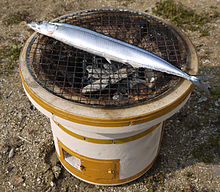
Shichirin (pronunciation; Japanese: 七輪, literally "seven wheels") is a small Japanese charcoal grill.
Etymology
Shichirin being a compound word made up of the characters 七 (shichi or nana, "seven") and 輪 (rin or wa, "wheel," "loop," or "ring"), its coinage can be suggested through the individual kanji. A popular story links the "rin" of shichirin to the Edo period currency denomination, the one-rin coin (albeit a different character, 厘). It is said that the shichirin was an affordable way to cook a meal because the amount of charcoal needed for each lighting only cost seven rin.
Description

The shichirin is a lightweight, compact, and easy-to-move cooking stove. Most modern shichirin are produced from rigid blocks of diatomaceous earth mined from deposits. These blocks of earth were then carved by hand or turned by machine before being fired in a kiln and affixed with metal hardware. Some shichirin are made with a double inside and outside ceramic structure.
Charcoal is chiefly used for the fuel. Shichirin are said to be made in roughly the same way today as in the Edo period, though both ceramic and diatomaceous earth versions were common. The shape is mainly cylindrical, square, or rectangular, and the size also varies. In the Kansai region, they are also known as kanteki.
-
A shichirin of the Edo period
-
With charcoal
-
Grilling sausages
-
 Grilling chikuwa
Grilling chikuwa
Use

Charcoal is commonly used as a fuel for a shichirin. For outdoor cooking, black charcoal is used. When indoors, binchōtan is preferred. Binchōtan, a type of white charcoal, produces less of a smell when burned, can continue burning hotly for a longer time, and is less likely to flare up dangerously. As a cheaper alternative, sawdust charcoal may be used.
North American "hibachi"
Main article: Hibachi
In North America, small BBQ cooking stoves resembling shichirin are referred to as "hibachi" or "hibachi-style", which in Japanese refers to a small heating device which is not usually used for cooking. It has been suggested that these grills were confusingly marketed as "hibachi" when they were introduced to North America. The word "hibachi" is also (incorrectly) used in some parts of the United States to refer to Japanese steak houses or teppanyaki "iron hot plate" restaurants.
See also
References
- "七輪". Gogen yurai jiten. 語源由来辞典. 3 April 2007. Retrieved 1 August 2019.
- THE MAKING (78)七輪ができるまで, 14 January 2014, archived from the original on 14 December 2021, retrieved 1 October 2021
- 「大野城市歴史資料展示室解説シート民俗No.14 民具1(食生活にかかわる民具)」大野城市教育委員会 Archived 2011-10-02 at the Wayback Machine
- 英語の「Hibachi」は火鉢じゃなかった exciteニュース 2005年6月2日
This article related to the culture of Japan is a stub. You can help Misplaced Pages by expanding it. |